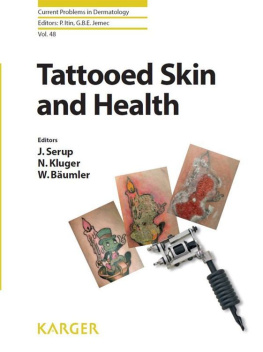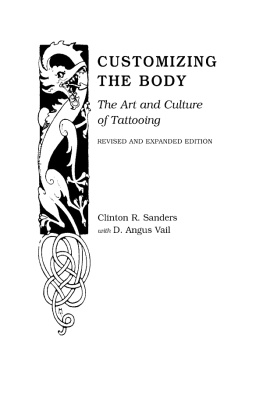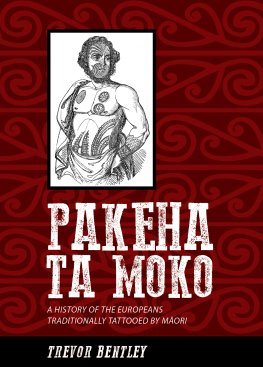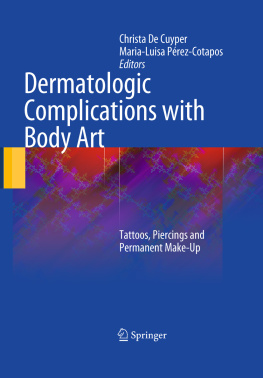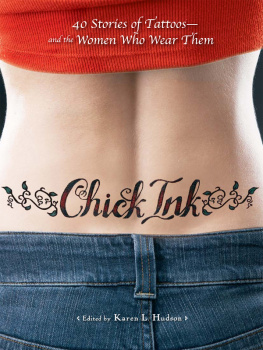Tattooed Skin and Health
Current Problems in Dermatology
Vol. 48
Series Editors
Peter Itin Basel
Gregor B.E. Jemec Roskilde
Tattooed Skin and Health
Volume Editors
Jrgen Serup Copenhagen
Nicolas Kluger Helsinki
Wolfgang Bumler Regensburg
110 figures, 85 in color, and 25 tables, 2015

Current Problems in Dermatology
______________________
Prof. Jrgen Serup
Bispebjerg University Hospital
Department of Dermatology D
Copenhagen (Denmark) | ______________________
Dr. Nicolas Kluger
Department of Skin and Allergic Diseases
Helsinki University Central Hospital
Helsinki (Finland) |
______________________
Prof. Wolfgang Bumler
Department of Dermatology
University of Regensburg
Regensburg (Germany) |
Library of Congress Cataloging-in-Publication Data
Tattooed skin and health / volume editors, Jrgen Serup, Nicolas Kluger, Wolfgang Bumler.
p. ; cm. (Current problems in dermatology, ISSN 1421-5721 ; vol. 48)
Includes bibliographical references and indexes.
ISBN 978-3-318-02776-1 (hard cover: alk. paper) ISBN 978-3-318-02777-8 (electronic version)
I. Serup, Jrgen, editor. II. Kluger, Nicolas, editor. III. Bumler, Wolfgang, 1959-, editor. IV. Series: Current problems in dermatology ; v.
48. 1421-5721
[DNLM: 1. Tattooingadverse effects. 2. Coloring Agents. 3. Epidermis-pathology. 4. Tattooinglegislation & jurisprudence. 5. Tattooingmethods. W1 CU804L v.48 2015 / WR 140]
GT2345
391.6'5dc23
2015000919
Bibliographic Indices. This publication is listed in bibliographic services, including MEDLINE/Pubmed.
Disclaimer. The statements, opinions and data contained in this publication are solely those of the individual authors and contributors and not of the publisher and the editor(s). The appearance of advertisements in the book is not a warranty, endorsement, or approval of the products or services advertised or of their effectiveness, quality or safety. The publisher and the editor(s) disclaim responsibility for any injury to persons or property resulting from any ideas, methods, instructions or products referred to in the content or advertisements.
Drug Dosage. The authors and the publisher have exerted every effort to ensure that drug selection and dosage set forth in this text are in accord with current recommendations and practice at the time of publication. However, in view of ongoing research, changes in government regulations, and the constant flow of information relating to drug therapy and drug reactions, the reader is urged to check the package insert for each drug for any change in indications and dosage and for added warnings and precautions. This is particularly important when the recommended agent is a new and/or infrequently employed drug.
All rights reserved. No part of this publication may be translated into other languages, reproduced or utilized in any form or by any means electronic or mechanical, including photocopying, recording, microcopying, or by any information storage and retrieval system, without permission in writing from the publisher.
Copyright 2015 by S. Karger AG, P.O. Box, CH-4009 Basel (Switzerland) and DOT/UETA (chapter by Schmidt)
www.karger.com
Printed in Germany on acid-free and non-aging paper (ISO 9706) by Kraft Druck, Ettlingen
ISSN 1421-5721
e-ISSN 1662-2944
ISBN 978-3-318-02776-1
e-ISBN 978-3-318-02777-8

Contents
Serup, J. (Copenhagen); Kluger, N. (Helsinki); Bumler, W. (Regensburg)
Krutak, L. (Washington, D.C.)
Kluger, N. (Helsinki)
Rosenkilde, F. (Copenhagen)
Kristensen, L. (Sor)
Kierstein, L. (Copenhagen); Kjelskau, K.C. (Oslo)
Kierstein, L. (Copenhagen)
Wedel Kristensen, M. (Copenhagen)
Serup, J.; Hutton Carlsen, K.; Sepehri, M. (Copenhagen)
De Cuyper, C. (Brugge)
Hutton Carlsen, K.; Serup, J. (Copenhagen)
Kluger, N. (Helsinki)
Eklund, Y.; Troilius Rubin, A. (Malm)
Grant, C.A.; Twigg, P.C.; Tobin, D.J. (Bradford)
Michel, R. (Neuburg am Rhein)
Barth, M. (Hackensack, N.J.)
Dirks, M. (Esslingen)
Dhne, L.; Schneider, J.; Lewe, D.; Petersen, H. (Berlin)
Petersen, H.; Lewe, D. (Berlin)
Agnello, M.; Fontana, M. (Grugliasco)
Prior, G. (Bielefeld)
Olsen, O. (Vedbaek)
Hauri, U.; Hohl, C. (Basel)
Jacobsen, N.R.; Clausen, P.A. (Copenhagen)
Bumler, W. (Regensburg)
Blume, A.; Platzek, T.; Vieth, B.; Hutzler, C.; Luch, A. (Berlin)
Bonadonna, L. (Rome)
Laux, P.; Luch, A. (Berlin)
Renzoni, A.; Pirrera, A.; Novello, F.; Diamante, M.S.; Guarino, C. (Rome)
Blass Rico, A.M. (Brussels)
Verdier, C. (Marines)
Veenstra, T. (Amsterdam)
Schmidt, A. (Willich-Neersen)
Bergstrm, J. (kersberga); Bodlund, M. (Helsingborg)
Serup, J. (Copenhagen)
Haugh, I.M.; Laumann, S.L.; Laumann, A.E. (Chicago, Ill.)
With some 100 million Europeans being tattooed, i.e. 10-20% of the adult population, it is timely to highlight tattooed skin and health.
Tattoos have been part of human history for thousands of years and have flourished due to people's emotions, aspirations and wishes to permanently express themselves as individuals. Today, as in the past, people hold the ownership of tattoos. Tattoos have a sunny side and a rebellious drive as well as a shadow. In modern society, tattoos are mainly decorative, used by both genders and span a broad range of social segments, age groups and ethnicities. The tattoo culture is global and serviced by a huge industry that operates across national borders and continents.
Unlike in the past, when soot and soil minerals were used for tattooing, tattoo colorants are now based on modern-pigment chemistry, which has allowed elaborate artwork on the skin. These pigments, however, entail a complex chemistry that is injected into the skin when getting a tattoo. Pigment particles are also sized in the nano-range. Modern scientific technologies that should be used to provide safer tattoo colorants and minimise the risk of the possible health concerns that come along with tattooing are now available. Tattooing can be considered the largest on-going human experiment on the injection of particles and chemicals into the human skin. However, this experiment has not been protocolled, has been off record, and has had no systematic surveillance. In contrast to the injection of medications based on one highly pure drug chemical, which passes astronomical regulatory requirements before being launched, the lack of regulation of tattooing is not logical.
The adverse events that we see in the clinic and know about have cast a shadow on tattooing and include allergic reactions from red tattoos, papulo-nodular reactions from black tattoos, scars and technical complications, psycho-social complications, and bacterial and viral infections, particularly those that may be life-threatening, such as acute blood infection and death, followed by slow-progressing viral infections and possible organ failure with a fatal outcome. The growing concern about multi-resistant bacteria, especially methicillin-resistant Staphylococcus aureus , as expressed in a warning by the World Health Organisation, is the number one future risk of tattooing. Therefore, the control of hygiene and sterility of inks is an urgent need. We don't see skin malignancies or malignancy of regional lymph nodes, which can be tattooed in cognito along with the skin. The potential carcinogenic risk of ink ingredients, such as polycyclic aromatic hydrocarbons, remains unconfirmed in the clinic, despite tattooed individuals being exposed to such a potential risk for a century. However, the research is scattered, and the potential risks to the body, internal organs and foetus are not excluded. The manufacturing of tattoo inks and chemical ingredients in inks cannot remain being not safeguarded.
Next page
